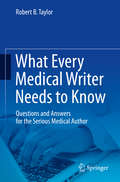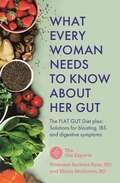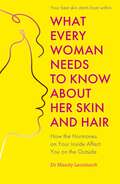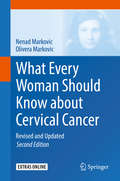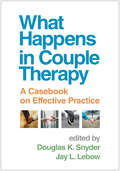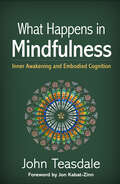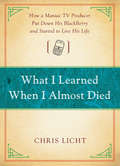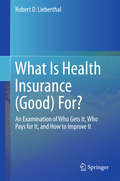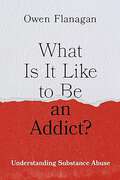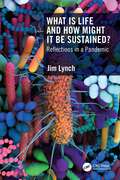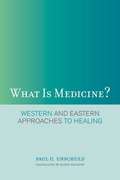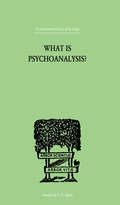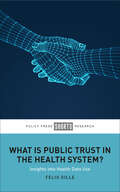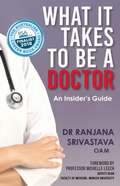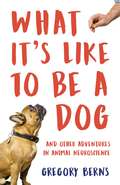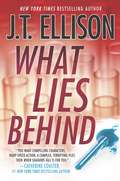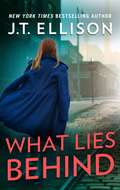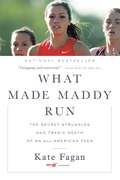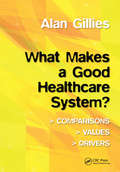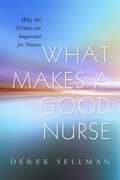- Table View
- List View
What Every Medical Writer Needs to Know
by Robert B. TaylorThis book presents must-know facts generally not covered in "How To" books about medical writing. Every medical writer, whether a beginner or veteran, needs answers to questions many might not even know to ask. How does your personality type influence your writing behavior, and what can you do to make writing easier for you? What should you ask before agreeing to co-author an article for publication or write a book chapter? What are some of the current issues regarding copyright and plagiarism that authors may face? What has research discovered about the quotations and references found in journal articles? What do you need to know about open access journals and predatory publishers? Dr. Taylor tells some surprising truths about medical publishing, including possible sources of peer review bias and some alarming influences on what ends up in print. He also relates little-known stories about renowned medical writers such as Sir William Osler, William Carlos Williams and Elisabeth Kübler-Ross and the origins of some of medicine's classic publications. What Every Medical Writer Needs to Know provides information vital for every health care professional who aspires to write for others to read: academicians and practicing physicians; nurses, nurse practitioners and physician assistants; and professional medical and scientific writers.
What Every Woman Needs to Know About Her Gut: The FLAT GUT Diet Plan
by Barbara Ryan Elaine McGowan* Digestive problems* Bloating* Diarrhoea* Constipation* PainDo you identify with these symptoms? Does your digestive system feel like your enemy? Is your unpredictable gut a source of embarrassment or fear, or is it holding you back?If you're a woman who's answered 'yes' to any of the above, you're not alone. More than two-thirds of people with IBS are female; other gut problems are also more common in women. And your needs are very specific.YOU NEED: Clear, accessible information about and insight into what female hormones can do to gut healthYOU NEED: Expert guidance from a consultant gastroenterologist and a clinical dietitian and nutritionistYOU NEED: Stepped, manageable strategies to take control of your troublesome gutYOU NEED: A diet plan that focuses on your specific requirements, which is flexible, achieveable and sustainableYOU NEED: Easy-to-follow recipes that are gut-friendly, delicious and restore your digestive healthYOU NEED THIS BOOK!Professor Barbara Ryan and Elaine McGowan, RD, are The Gut Experts (@thegutexperts and www.thegutexperts.com) and have treated over 60,000 patients with every kind of digestive condition and nutritional requirement. They are bringing their expertise and insights to you in this easy-to-digest book.
What Every Woman Needs to Know About Her Gut: The FLAT GUT Diet Plan
by Barbara Ryan Elaine McGowan* Digestive problems* Bloating* Diarrhoea* Constipation* PainDo you identify with these symptoms? Does your digestive system feel like your enemy? Is your unpredictable gut a source of embarrassment or fear, or is it holding you back?If you're a woman who's answered 'yes' to any of the above, you're not alone. More than two-thirds of people with IBS are female; other gut problems are also more common in women. And your needs are very specific.YOU NEED: Clear, accessible information about and insight into what female hormones can do to gut healthYOU NEED: Expert guidance from a consultant gastroenterologist and a clinical dietitian and nutritionistYOU NEED: Stepped, manageable strategies to take control of your troublesome gutYOU NEED: A diet plan that focuses on your specific requirements, which is flexible, achieveable and sustainableYOU NEED: Easy-to-follow recipes that are gut-friendly, delicious and restore your digestive healthYOU NEED THIS BOOK!Professor Barbara Ryan and Elaine McGowan, RD, are The Gut Experts (@thegutexperts and www.thegutexperts.com) and have treated over 60,000 patients with every kind of digestive condition and nutritional requirement. They are bringing their expertise and insights to you in this easy-to-digest book.
What Every Woman Needs to Know About Her Skin and Hair: How the hormones on your inside affect you on the outside (What Every Woman Needs to Know)
by Dr Mandy LeonhardtThe appearance of our skin and hair has a huge impact on our psychological wellbeing and confidence. Women feel pressure to have glowing, blemish-free skin, and thick, luscious hair at all times - in reality, our skin is a dynamic living organ which reacts to hormonal changes across the lifecycle, from puberty to the menopause. When our skin does not look healthy, and when our hair is thin or falling out, we want to understand why, and what we can do about it. We can spend large amounts on different creams and beauty products, or cover the problem with makeup, but ultimately the question most asked by women, and unanswered by skincare regimes, is 'could this be hormonal?'The answer is, of course, 'yes' - and if you read this book, you'll know exactly how and why. By giving you a better understanding of the relationship between your hormones, and common skin and hair problems, Dr Mandy Leonhardt will help you find lasting solutions whatever your issue. Whether you suffer with outbreaks, dry skin, sensitive skin, pigmentation or are concerned about the way your skin is aging in midlife, What Every Woman Needs to Know About Her Skin and Hair will provide you with the tools to find more holistic and effective solutions which don't just scratch (or moisturise) the surface, but which look at the root cause of the problem. Drawing on both the latest research and on her years of experience as a GP and specialist in women's health, Dr Leonhardt offers scientifically proven and practical advice to both understand and better manage the condition of your skin, hair and nails. She will explain which skincare principles (and types of product) are worthwhile, and which aren't; and how you can effectively connect the dots between your skin health and factors like nutrition and lifestyle. She gives clear advice on which non-medical treatments are worth pursuing (and, again, which aren't), and plenty of additional resources to help you find a cost-effective regime which takes both your hormonal stage in life and your bank balance into account.
What Every Woman Needs to Know About Her Skin and Hair: How the hormones on your inside affect you on the outside (What Every Woman Needs to Know)
by Dr Mandy LeonhardtThe appearance of our skin and hair has a huge impact on our psychological wellbeing and confidence. Women feel pressure to have glowing, blemish-free skin, and thick, luscious hair at all times - in reality, our skin is a dynamic living organ which reacts to hormonal changes across the lifecycle, from puberty to the menopause. When our skin does not look healthy, and when our hair is thin or falling out, we want to understand why, and what we can do about it. We can spend large amounts on different creams and beauty products, or cover the problem with makeup, but ultimately the question most asked by women, and unanswered by skincare regimes, is 'could this be hormonal?'The answer is, of course, 'yes' - and if you read this book, you'll know exactly how and why. By giving you a better understanding of the relationship between your hormones, and common skin and hair problems, Dr Mandy Leonhardt will help you find lasting solutions whatever your issue. Whether you suffer with outbreaks, dry skin, sensitive skin, pigmentation or are concerned about the way your skin is aging in midlife, What Every Woman Needs to Know About Her Skin and Hair will provide you with the tools to find more holistic and effective solutions which don't just scratch (or moisturise) the surface, but which look at the root cause of the problem. Drawing on both the latest research and on her years of experience as a GP and specialist in women's health, Dr Leonhardt offers scientifically proven and practical advice to both understand and better manage the condition of your skin, hair and nails. She will explain which skincare principles (and types of product) are worthwhile, and which aren't; and how you can effectively connect the dots between your skin health and factors like nutrition and lifestyle. She gives clear advice on which non-medical treatments are worth pursuing (and, again, which aren't), and plenty of additional resources to help you find a cost-effective regime which takes both your hormonal stage in life and your bank balance into account.
What Every Woman Should Know about Cervical Cancer
by Nenad Markovic Olivera MarkovicThis book (anupdated and extended edition) is about mobilizing women and health care policymakers and providers to unite their efforts in a single strategy for fightingcervical cancer worldwide. The objective of this strategy would be to reversecervical cancer prevalence and mortality rates among all 2. 4 billion women atrisk and to achieve this goal within 10-15 years of implementation. CervicalCancer Screening (Pap test, VIA, VILI, or HPV) failed to stop cervical cancerworldwide simply because many countries could not afford developinginfrastructure necessary to carry on the global strategy, and because theoutreach could not accomplish the targeted 51% of the population at risk. In2015, there is still 600,000 women getting cervical cancer annually and 300,000of them die. Every minute one woman gets cervical cancer and every 2 minutesone woman dies from this preventable disease. In 21st Centurythe Information Technology (IT) Revolution has made substantial impact onmedicine enabling remote points-of care, scattered around the world, to bee-connected with experts in distant medical centers and to obtain qualitydiagnosis and proper guidelines for curative therapy of early stages ofcervical cancer. Low frequency of costly interventions needed makes IT-basedscreening financially and socially beneficial for mass screening. This newMobile Health technology with the Global Strategy for Fighting Cervical Canceris subject to elaboration in our book as the new hope when old efforts havefailed to stop the world "epidemics" of this grave but preventable disease. Thelanguage is adapted for easy reading and understanding by professionals andlay-persons. This book isintended for women at risk for cervical cancer, their health care providers,health insurance companies, government responsible for making health policy andhealthcare industry because all of them have special role in the new GlobalStrategy elaborated in details in this book.
What Happens in Couple Therapy: A Casebook on Effective Practice
by Jay L. Lebow Douglas K. SnyderBringing contemporary couple therapy to life, this casebook candidly illustrates the "whats," "whys," and "how-tos" of leading clinical approaches. Well-known contributors provide a window into their work with couples seeking help for a variety of relationship challenges. Cases depict the moment-by-moment process of therapy, from the initial assessment and case formulation through the beginning, intermediate, and concluding phases. Themes addressed include working across cultural divides; helping couples living with psychological or medical disorders; and treating interfaith couples, military couples, and same-sex and queer couples. Enhancing the book's utility for course use, the expert editors concisely introduce each case and describe how the approach fits into the broader field. See also Lebow and Snyder's Clinical Handbook of Couple Therapy, Sixth Edition, which provides an authoritative overview of theory and practice.
What Happens in Mindfulness: Inner Awakening and Embodied Cognition
by John TeasdaleWell known for applying mindfulness to the treatment of depression, pioneering researcher John Teasdale now explores the broader changes that people can experience through contemplative practices. What goes on in our minds when we are mindful? What does it mean to talk of mindfulness as a way of being? From a scientific perspective, how do core elements of contemplative traditions have their beneficial effects? Teasdale describes two types of knowing that human beings have evolved--conceptual and holistic–intuitive--and shows how mindfulness can achieve a healthier balance between them. He masterfully describes the mechanisms by which this shift in consciousness not only can reduce emotional suffering, but also can lead to greater joy and compassion and a transformed sense of self.
What I Learned When I Almost Died
by Chris LichtWhat do you learn when your brain goes pop? Chris Licht had always been ambitious. When he was only nine years old, he tracked down an NBC correspondent while on vacation to solicit advice for a career in television. At eleven, he began filming himself as he delivered the news. And by the time he was thirty-five, he landed his dream job: a fast-paced, demanding spot at the helm of MSNBC's Morning Joe--one of the most popular shows on cable TV. He had become a real-life Jerry Maguire: hard-charging, obsessively competitive, and willing to sacrifice anything to get it done. He felt invincible. Then one day Chris heard a pop in his head, followed by a whoosh of blood and crippling pain. Doctors at the ER said he had suffered a near-deadly brain hemorrhage. Chris's life had almost been cut short, and he had eight long days in a hospital bed to think about it. What I Learned When I Almost Died tells the story of what happened next.
What I Say: Conversations That Improve the Physician-Patient Relationship
by Jack Parker Robert OsherPhysicians of all disciplines know (or quickly learn the hard way) that effective and compassionate communication is arguably the single most important determinant of patient satisfaction. For cataract surgeons, the words said before, after, and even during the operation are often more important to the patient’s happiness than the objective quality of the surgical result.What I Say: Conversations that Improve the Physician-Patient Relationship is designed to help cataract surgeons to hone their verbal interactions to be as sharp as their surgical skills. Muddled, clumsy, or impromptu explanations diminish the doctor-patient relationship and could prevent patients from receiving the surgery they need or appreciating the results they get. Knowing in advance which words to use in difficult situations is analogous to knowing how to manage a complication before it occurs. The results are inevitably better when a physician has considered every possible outcome instead of attempting to come up with exactly the right solution on the spot. Rather than figure out the right words by trial and error, however, What I Say has recommendations on exactly what to say to build strong and trusting patient relationships. Drs. Robert Osher and Jack Parker have compiled conversational scripts from Dr. Osher’s 40-year career in ophthalmology, as well as contributions from over a dozen international mavens of bedside manner into a strategy guide through even the most difficult patient conversations that inevitably surround cataract surgery.Topics include: Lowering Expectations for Spectacle-Free Vision The Torn Posterior Capsule Postoperative Refractive Surprise The Dropped Nucleus The Unhappy Patient Despite a Good Result Containing examples of conversations with cataract surgery patients where informing and reassuring take top priority, What I Say: Conversations that Improve the Physician-Patient Relationship was created to aid cataract surgeons in their pre-operative, intra-operative, and post-operative interactions with patients. With the advice contained inside, surgeons will be able to motivate patients, calibrate expectations, and diffuse frustrations in every possible scenario.
What Is Health Insurance (Good) For?
by Robert D. LieberthalThis informative volume synthesizes the literatures on health economics, risk management, and health services into a concise guide to the financial and social basics of health insurance with an eye to its wide-scale upgrade. Its scope takes in concepts of health capital, strengths and limitations of insurance models, the effectiveness of coverage and services, and the roles of healthcare providers and government agencies in the equation. Coverage surveys the current state of group and public policies, most notably the effects of the Affordable Care Act on insurers and consumers and the current interest in universal coverage and single-payer plans. Throughout, the author provides systemic reasons to explain why today s health insurance fails so many consumers, concluding with reality-based recommendations for making insurance more valuable to both today s market and consumer well-being. Included among the topics: . Defining health insurance and healthcare finance. . Consuming and investing in health. . The scope of health insurance and its constraints. . Matching health insurance supply and demand. . The role of government in health insurance. . Ongoing challenges and the future of health insurance. Bringing a needed degree of objectivity to often highly subjective material, "What Is Health Insurance (Good) For?" is a call to reform to be read by health insurance researchers (including risk management insurance and health services research), professionals, practitioners, and policymakers. "
What Is It Like to Be an Addict?: Understanding Substance Abuse
by Owen FlanaganA powerful and important exploration of how addiction functions on social, psychological and biological levels, integrated with the experience of being an addict, from an acclaimed philosopher and former addict. <P><P> What is addiction? Theories about what kind of thing addiction is are sharply divided between those who see it purely as a brain disorder, and those who conceive of it in psychological and social terms. Owen Flanagan, an acclaimed philosopher of mind and ethics, offers a state-of-the-art assessment of addiction science and proposes a new ecumenical model for understanding and explaining substance addiction. <P><P> Flanagan has first-hand knowledge of what it is like to be an addict. That experience, along with his wide-ranging knowledge of the philosophy of mind, psychology, neuroscience, and the ethics and politics of addiction, informs this important and novel work. He pairs the sciences that study addiction with a sophisticated view of the consciousness-brain/body relation to make his core argument: that substance addictions comprise a heterogeneous set of "psychobiosocial" behavioral disorders. He explains that substance addictions do not have one set of causes, such as self-medication or social dislocation, and they do not have one neural profile, such as a dysfunction in dopamine system. Some addictions are fun and experimentation gone awry. Flanagan reveals addiction to be a heterogeneous set of disorders, which are picked out by multifarious cultural, social, psychological, and neural features. <P><P> Flanagan explores the ways addicts sensibly insist on their own responsibility to undo addiction, as well as ways in which shame for addiction can be leveraged into healing. He insists on the collective shame we all bear for our indifference to many of the psychological and social causes of addiction and explores the implications of this new integrated paradigm for practices of harm reduction and treatment. Flanagan's powerful new book upends longstanding conventional thinking and points the way to new ways of understanding and treating addiction.
What Is Life and How Might It Be Sustained?: Reflections in a Pandemic
by Jim LynchHow did the universe and life begin and what are the threats to people and the environment in a pandemic? This book is for anybody with interest in protecting life on the planet. Studies on the origin of life and scientific contributions to safeguarding the planet are examined in light of current thinking on climate change. A major focus is the spread of microbes, put in the context of environmental assessment and management, including descriptions of microbiomes and a consideration of the risks of genetic modifications. Professor Lynch shows how failure to control disease can lead to the collapse of any biotic population. To avoid this, the ethics of management of disease by biological control and by vaccination are discussed, at the practical level and in a moral theological context.
What Is Medicine? Western and Eastern Approaches to Healing
by Paul U. Unschuld Karen ReimersThis book depicts the fascinating development of medical thought in West and East. It shows the close bond between medical thought and the prevailing social and economic conditions governing man's living environment.
What Is Psychoanalysis?
by Coriat, Isador HFirst Published in 1999. Routledge is an imprint of Taylor & Francis, an informa company.
What Is Public Trust in the Health System?: Insights into Health Data Use
by Felix GilleEPDF and EPUB available Open Access under CC-BY-ND licence. This book explores the concept of public trust in health systems. In the context of recent events, including public response to interventions to tackle the COVID-19 pandemic, vaccination uptake and the use of health data and digital health, this important book uses empirical evidence to address why public trust is vital to a well-functioning health system. In doing so, it provides a comprehensive contemporary explanation of public trust, how it affects health systems and how it can be nurtured and maintained as an integral component of health system governance.
What It Means to Be Human: The Case For The Body In Public Bioethics
by O. Carter SneadA leading expert on public bioethics advocates for a new conception of human identity in American law and policy.The natural limits of the human body make us vulnerable and therefore dependent, throughout our lives, on others. Yet American law and policy disregard these stubborn facts, with statutes and judicial decisions that presume people to be autonomous, defined by their capacity to choose. As legal scholar O. Carter Snead points out, this individualistic ideology captures important truths about human freedom, but it also means that we have no obligations to each other unless we actively, voluntarily embrace them. Under such circumstances, the neediest must rely on charitable care. When it is not forthcoming, law and policy cannot adequately respond.What It Means to Be Human makes the case for a new paradigm, one that better represents the gifts and challenges of being human. Inspired by the insights of Alasdair MacIntyre and Charles Taylor, Snead proposes a vision of human identity and flourishing that supports those who are profoundly vulnerable and dependent—children, the disabled, and the elderly. To show how such a vision would affect law and policy, he addresses three complex issues in bioethics: abortion, assisted reproductive technology, and end-of-life decisions. Avoiding typical dichotomies of conservative-versus-liberal and secular-versus-religious, Snead recasts debates over these issues and situates them within his framework of embodiment and dependence. He concludes that, if the law is built on premises that reflect the fully lived reality of life, it will provide support for the vulnerable, including the unborn, mothers, families, and those nearing the end of their lives. In this way, he argues, policy can ensure that people have the care they need in order to thrive.In this provocative and consequential book, Snead rethinks how the law represents human experiences so that it might govern more wisely, justly, and humanely.
What It Takes to Be a Doctor: An Insider's Guide
by Ranjana SrivastavaIf you, or someone you know, is thinking of becoming a doctor, you can’t go past this essential guide from one of Australia’s finest doctors – and writers. What is the life of a doctor really like? Is there an end to studying? Are money and prestige guaranteed? Can a fulfilling medical career and a satisfying family life co-exist and what support can a parent or partner give? Which doctors are the happiest? What is the most important question to ask yourself before studying medicine? An insider’s calm and considered answers could determine whether you choose to pursue this high-stakes career. Becoming a doctor is a tremendous privilege and a serious responsibility. With her trademark warmth and story-telling ability, Ranjana Srivastava delves into the reality of being a doctor in the modern era of medicine. Through lived experience as a front-line clinician, prolific writer, and mother, she celebrates the highlights of being a doctor but doesn't flinch from the disappointments. Her compelling stories illustrate the hidden facets of a life in medicine. From the burden of prolonged medical training and the regret of mismatched expectations, to the humility of caring and the joy of making a difference, this book contains illuminating observations, reflection and advice that should be required reading for anyone contemplating a career as a doctor.
What It's Like to Be a Dog: And Other Adventures in Animal Neuroscience
by Gregory BernsWhat does your dog really think about you? To find out, Gregory Berns became the first neuroscientist to persuade dogs to lie in an MRI machine wide awake. Now we know more about our best friends than ever before – how varying capacities for self-control and different value systems set them apart as individuals, and how deeply they understand the words we speak to them. Berns&’ discoveries have profound implications for how we communicate with and treat these beloved animals. But he didn&’t stop there. Berns also delves into the inner lives of sea lions, bats, dolphins, and even the extinct Tasmanian tiger. His revolutionary explorations are essential reading for animal lovers of all stripes.
What Killed Jane Austen?
by Jim Leavesley George Biro Greg SmithTales of famous patients, doctors, discoveries and disasters.
What Lies Behind
by J. T. EllisonCritically acclaimed New York Times bestselling author J. T. Ellison delivers another riveting novel featuring the incomparable Dr. Samantha Owens Waking to sirens in the night is hardly unusual for Samantha Owens. No longer a medical examiner, she doesn't lose sleep over them, but a routine police investigation in her neighborhood has her curious. When her homicide detective friend, Darren Fletcher, invites her to look over the evidence, she jumps at the chance and immediately realizes the crime scene has been staged. What seems to be a clear case of murder/suicide-a crime of passion-is anything but. The discovery of toxic substances in hidden vials indicates that something much more sinister is at play... As Fletch and Sam try to understand what and who they are dealing with, they are summoned to a meeting at the State Department. High-level officials are interested in what they know and seem to be keeping secrets of their own. It's up to Sam and Fletch to uncover what lies behind the deception as the threat of bioterrorism is exposed, and her boyfriend, Xander Whitfield, may be in the line of fire. Unsure who to trust, Sam and Fletch find themselves up against very powerful people at every stage in the investigation. No one is who they appear to be and with every minute that passes, the danger escalates. It's Sam's most complex case yet and the terrifying reality is beyond anything she could have imagined.
What Lies Behind: When Shadows Fall What Lies Behind (A Samantha Owens Novel #4)
by J. T. EllisonThe fourth riveting novel featuring the incomparable Dr. Samantha Owens, by critically acclaimed New York Times bestselling author J.T. Ellison “WHAT LIES BEHIND grabs you by the throat and doesn’t let go. Ellison is a great talent—enjoy.” —Catherine Coulter, # 1 New York Times bestselling authorWaking to sirens in the night is hardly unusual for Sam Owens. No longer a medical examiner, she doesn’t lose sleep over them, but a routine police investigation in her neighborhood has her curious. When her homicide detective friend, Darren Fletcher, invites her to look over the evidence, she immediately realizes the crime scene has been staged. What would seem to be a clear case of murder/suicide is anything but. The discovery of toxic substances in hidden vials indicates that something much more sinister is at play… As Fletch and Sam try to understand what and who they are dealing with, they are summoned to a meeting at the State Department. High-level officials are interested in what they know and, as the threat of bioterrorism is exposed, seem to be keeping secrets of their own. Unsure who to trust, Sam and Fletch find themselves up against very powerful people at every stage in the investigation. It’s Sam’s most complex case yet, and the terrifying reality is beyond anything she could have imagined.Originally published in 2015
What Made Maddy Run: The Secret Struggles and Tragic Death of an All-American Teen
by Kate FaganFrom noted ESPN commentator and journalist Kate Fagan, the heartbreaking and vital story of college athlete Madison Holleran, whose death by suicide rocked the University of Pennsylvania campus and whose life reveals with haunting detail and uncommon understanding the struggle of young people suffering from mental illness todayIf you scrolled through the Instagram feed of 19-year-old Maddy Holleran, you would see a perfect life: a freshman at an Ivy League school, recruited for the track team, who was also beautiful, popular, and fiercely intelligent. This was a girl who succeeded at everything she tried, and who was only getting started. But when Maddy began her long-awaited college career, her parents noticed something changed. Previously indefatigable Maddy became withdrawn, and her thoughts centered on how she could change her life. In spite of thousands of hours of practice and study, she contemplated transferring from the school that had once been her dream. When Maddy's dad, Jim, dropped her off for the first day of spring semester, she held him a second longer than usual. That would be the last time Jim would see his daughter.WHAT MADE MADDY RUN began as a piece that Kate Fagan, a columnist for espnW, wrote about Maddy's life. What started as a profile of a successful young athlete whose life ended in suicide became so much larger when Fagan started to hear from other college athletes also struggling with mental illness. This is the story of Maddy Holleran's life, and her struggle with depression, which also reveals the mounting pressures young people, and college athletes in particular, face to be perfect, especially in an age of relentless connectivity and social media saturation.
What Makes a Good Healthcare System?: Comparisons, Values, Drivers
by Alan GilliesFirst Published in 2018. Routledge is an imprint of Taylor & Francis, an Informa company. What Makes a Good Health Care System? Examines the various assumptions that underpin the different views of what makes a good health care system. The national systems in the UK, Australia and Canada are thoroughly examined. Each country has a different view of what a good health care system is trying to achieve, and the book elucidates these by highlighting key policy documents and comments from key stakeholders. Case studies emphasise the diverse needs and expectations of individuals, examining and comparing concepts of health needs, quality as a measure of 'good-ness' and the various ideas on Gold Standards. This book will be valuable reading for all healthcare managers and clinicians with management responsibilities, as well as policy makers and shapers and all those with a general interest in health.
What Makes a Good Nurse
by Derek SellmanIn recent years, the human values at the heart of the nursing profession seem to have become side-lined by an increased focus on managerialist approaches to health care provision. Nursing's values are in danger of becoming marginalised further precisely because that which nursing does best - providing care and helping individuals through the human trauma of illness - is difficult to measure, and therefore plays little, if any, part in official accounts of outcome measures. Derek Sellman sets out the case for re-establishing the primacy of the virtues that underpin the practice of nursing in order to address the question: what makes a good nurse? He provides those in the caring professions with both a rationale and a practical understanding of the importance that particular character traits, including justice, courage, honesty, trustworthiness and open-mindedness, play in the practice of nursing, and explains why and how nurses should strive to cultivate these virtues, as well as the implications of this for practice. This original and thought-provoking book will be essential reading for nurses and nursing students, care workers, care commissioners, and many others who work in the caring professions.
